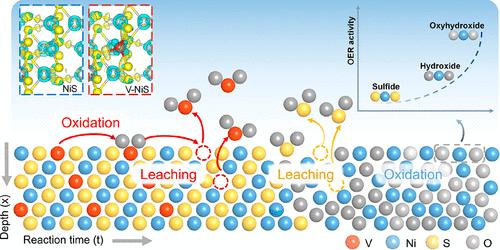当前位置:
X-MOL 学术
›
Nano Lett.
›
论文详情
Our official English website, www.x-mol.net, welcomes your
feedback! (Note: you will need to create a separate account there.)
Cationic Oxidative Leaching Engineering Modulated In Situ Self-Reconstruction of Nickel Sulfide for Superior Water Oxidation
Nano Letters ( IF 9.6 ) Pub Date : 2023-05-30 , DOI: 10.1021/acs.nanolett.3c00885 Xuanzhi Liu 1 , Jianchuan Wang 1 , Hanxiao Liao 1 , Jiaoyang Chen 1 , Shaohui Zhang 1 , Liming Tan 1 , Xusheng Zheng 2 , Dewei Chu 3 , Penfei Tan 1 , Jun Pan 1
Nano Letters ( IF 9.6 ) Pub Date : 2023-05-30 , DOI: 10.1021/acs.nanolett.3c00885 Xuanzhi Liu 1 , Jianchuan Wang 1 , Hanxiao Liao 1 , Jiaoyang Chen 1 , Shaohui Zhang 1 , Liming Tan 1 , Xusheng Zheng 2 , Dewei Chu 3 , Penfei Tan 1 , Jun Pan 1
Affiliation

|
Tuning the electroactive surface species of electrocatalysts remains a significant challenge for achieving highly efficient oxygen evolution reactions. Herein, we propose an innovative in situ leaching strategy, modulated by cationic oxidation, to achieve active self-reconstruction of these catalysts. Vanadium is introduced as a cation into Ni3S2 and oxidized under low oxidative potential, leading to subsequent leaching into the electrolyte and triggering self-reconstruction. The structural evolution from V-Ni3S2 to Ni(OH)2 and subsequently to NiOOH is identified by operando Raman as a three-step transition. In contrast, V-free Ni3S2 is unable to bypass the thermodynamically predicted nickel oxysulfide products to transform into active NiOOH. As a result, the self-restructured V-Ni3S2 only needs an ultralow overpotential of 155 mV at 10 mA cm–2, outperforming V-free Ni3S2 and many other advanced catalysts. This work provides new guidelines for manipulating in situ leaching to modulate the self-reconstruction of catalysts.
中文翻译:

阳离子氧化浸出工程调节硫化镍的原位自重构以实现优异的水氧化
调整电催化剂的电活性表面物质仍然是实现高效析氧反应的重大挑战。在此,我们提出了一种创新的原位浸出策略,通过阳离子氧化进行调节,以实现这些催化剂的主动自重构。钒作为阳离子引入 Ni 3 S 2并在低氧化电位下被氧化,导致随后浸出到电解质中并引发自我重建。从 V-Ni 3 S 2到 Ni(OH) 2和随后到 NiOOH的结构演化被原位拉曼鉴定为三步转变。相反,无 V 的 Ni 3S 2无法绕过热力学预测的氧硫化镍产物转化为活性NiOOH。因此,自重组的 V-Ni 3 S 2在 10 mA cm –2下仅需要 155 mV 的超低过电势,优于不含 V 的 Ni 3 S 2和许多其他先进催化剂。这项工作为操纵原位浸出以调节催化剂的自重构提供了新的指导方针。
更新日期:2023-05-30
中文翻译:

阳离子氧化浸出工程调节硫化镍的原位自重构以实现优异的水氧化
调整电催化剂的电活性表面物质仍然是实现高效析氧反应的重大挑战。在此,我们提出了一种创新的原位浸出策略,通过阳离子氧化进行调节,以实现这些催化剂的主动自重构。钒作为阳离子引入 Ni 3 S 2并在低氧化电位下被氧化,导致随后浸出到电解质中并引发自我重建。从 V-Ni 3 S 2到 Ni(OH) 2和随后到 NiOOH的结构演化被原位拉曼鉴定为三步转变。相反,无 V 的 Ni 3S 2无法绕过热力学预测的氧硫化镍产物转化为活性NiOOH。因此,自重组的 V-Ni 3 S 2在 10 mA cm –2下仅需要 155 mV 的超低过电势,优于不含 V 的 Ni 3 S 2和许多其他先进催化剂。这项工作为操纵原位浸出以调节催化剂的自重构提供了新的指导方针。





















































 京公网安备 11010802027423号
京公网安备 11010802027423号